A quarter dollar, or quarter, is a U.S. coin worth 25 cents, or one quarter of a dollar. It has been produced since 1796. The choice of 0.25 as a denomination, as opposed to 0.20, which is more common in other parts of the world, originated with the practice of dividing Spanish Milled Dollars into eight wedge shaped segments (each called a "piece of eight"). At one time "two bits", that is, two wedges, each wedge an eighth, thus a quarter of the Spanish real, was a common nickname for a quarter.
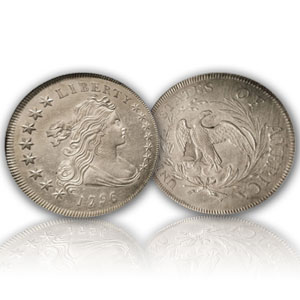
The design of the 1796 Draped Bust quarter had its genesis in the almost universal dislike for the previous coin designs. Earlier copper coinage, such as the Chain cent and Wreath cent had not been well received by the public, and the Flowing Hair design of the silver coins was widely criticized. To avoid such public embarrassment with the new design, Mint Director Henry DeSaussure engaged renowned portraitist Gilbert Stuart, who used as his model the prominent Philadelphia socialite Mrs. William Bingham (nee Ann Willing). The likeness of the buxom Mrs. Bingham was first applied to the Draped Bust dollar issued late in 1795.
Only 6,146 of the new quarters were struck in 1796. There are only two varieties known, one with a low 6 in the date and the other with a high 6, the Low 6 variety being much the rarer of the two. Collectors generally want only one coin for a type set, and herein lies the enduring popularity of the 1796 quarter. While it is not a particularly rare coin for the era, anyone who attempts to complete a type set of United States coins must have a 1796 quarter, as this design was made in only this one year. The next design type (not coined until 1804) retained the draped bust design on the obverse but replaced the small eagle of 1796 with the heraldic eagle that was then current on the other silver coins of the day.
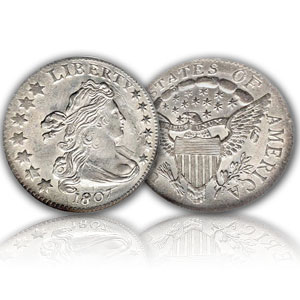
By 1804, the Mint had settled on 13 stars representing the original states; the notion of adding a star every time a state joined the union had been scrapped as an impractical indulgence.
13 stars appear on the reverse of the Heraldic Eagle quarter, as well, tucked into the space above the eagle’s head. There are clouds above the eagle, while UNITED STATES OF AMERICA and 25 C. are inscribed around the periphery. A shield is superimposed upon the eagle’s breast, a banner in its beak proclaims E PLURIBUS UNUM, and it grasps symbolic items: a sheaf of arrows and an olive branch. In designing the coin, Chief Engraver Scot chose to place the warlike arrows in the right (or “dexter”) claw and the olive branch of peace in the left (or “sinister”) claw. This reverses the traditional American priorities, since the right claw is dominant in heraldry and thus more properly suited for a symbol of peace, not war.
The Draped Bust/Heraldic Eagle quarter remained in production for only four years, and during that time its annual mintage never reached a quarter of a million. Only 6,738 examples were struck in 1804, making that the key date of the series. Thereafter, the output topped 100,000 every year, reaching a high of 220,643 in 1807. Combined production for all four years totaled only 554,899.
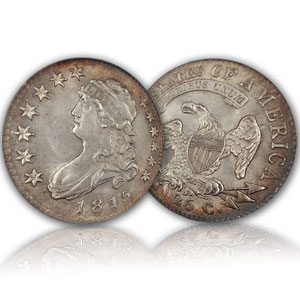
The Capped Bust design was introduced by Chief Engraver of the Mint, William Kneass. It proved to be a popular design and lasted from 1807 to 1839 on the half dollar, 1809 to 1837 on the dime and half dime, and 1815 to 1838 on the quarter.
There was also a gold design created by engraver Robert Scot created in 1795, also called the Capped Bust, although it is more popularly known as the "Turban Head" because of its unusual, exotic appearance. The Turban design was used on the gold Quarter Eagle, Half Eagle, and Eagle from 1795 to 1834. On the Quarter and Half Eagles, the Turban design was replaced with the regular Capped Bust design in 1807, however the Eagle stayed with the original design until it was replaced with the "Coronet" Liberty Head design in 1838, having stopped production of the Eagle in 1804.
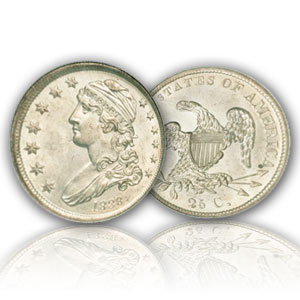
The design for the Capped Bust Quarter was created by German immigrant John Reich, who had been hired as an assistant to Robert Scot. It was Reich’s first task in 1807 to redesign circulating coinage, however the quarter would have to wait 1815 for the new design to be introduced. The obverse features a familiar bust of Liberty, facing left. She is wearing a cap, often referred to as a Phrygian or Freedom Cap, with a band inscribed with the word LIBERTY. On both sides are stars, seven left and six right, representing the original thirteen states. The date appears below, slightly curved.
The reverse features a design which would be found on circulating coins into the late 19th century. A bald eagle with wings spread is seen at the center, with a bundle of arrows and an olive branch in its claws. On the eagle’s breast is a large shield, with horizontal and vertical lines. A scroll is included above with the inscription E PLURIBUS UNUM. Starting closely above the eagle’s right wing is the inscription UNITED STATES OF AMERICA, which ends next to the other wing. The denomination is found below, expressed as 25 C. This represented the first time the value was indicated on the quarter dollar denomination.
The Capped Bust Quarter featuring the original design was struck from 1815 to 1828. After a hiatus in production of three years, a modified design would be introduced in 1831. The coins were smaller in diameter, with details more finely executed and smaller dentils around the edge of the coin. The most notable change was the removal of the scroll bearing the E PLURIBUS UNUM motto on the reverse of the coin. These design changes were made by William Kneass, successor to Scot as the Chief Engraver at the Mint. The design changes also coincided with the relocation of the Mint to a new building and the acquisition of improved machinery.
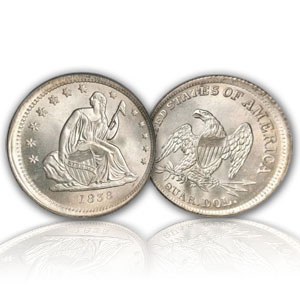
Seated Liberty quarters, made from 1838 through 1891, represent a long era in United States coin history. Seated Liberty quarters were the coinage of a divided nation during the Civil War.
Seated Liberty quarter production continued through Reconstruction and into the 1890s, when some of the modern conveniences of telephones, electric light bulbs, and even prototypes for automobiles were just coming into use.
Indeed, the Seated Liberty quarter was an important coin at an important time in United States history. Seated Liberty quarters were designed by Christian Gobrecht. The reverse of Seated Liberty coinage depicts an eagle clutching arrows and an olive branch. The Seated Liberty design appeared on virtually all silver coinage of the mid-to-late 19th century, becoming one of the longest-running coin designs in American history.
Over the course of more than half a century of the Seated Liberty design on the quarter, some 5 varieties of the design resulted, thanks to minor modifications of the lettering and symbols on the coin.
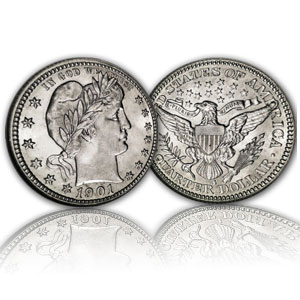
The Barber coinage consisted of a dime, quarter, and half dollar designed by United States Bureau of the Mint Chief Engraver Charles E. Barber. They were minted between 1892 and 1916, though no half dollars were struck in the final year of the series.
By the late 1880s, there were increasing calls for the replacement of the Seated Liberty design, used since the 1830s on most denominations of silver coins. In 1891, Mint Director Edward O. Leech, having been authorized by Congress to approve coin redesigns, ordered a competition, seeking a new look for the silver coins. As only the winner would receive a cash prize, invited artists refused to participate and no entry from the general public proved suitable. Leech instructed Barber to prepare new designs for the dime, quarter, and half dollar, and after the chief engraver made changes to secure Leech's endorsement, they were approved by President Benjamin Harrison in November 1891. Striking of the new coins began the following January.
Public and artistic opinion of the new pieces was, and remains, mixed. In 1915, Mint officials began plans to replace them, after the design's minimum term expired in 1916. The Mint issued Barber dimes and quarters in 1916 to meet commercial demand, but before the end of the year, the Mercury dime, Standing Liberty quarter, and Walking Liberty half dollar had begun production. Most dates in the Barber coin series are not difficult to obtain, but the 1894 dime struck at the San Francisco Mint (1894-S), with a mintage of 24, is a great rarity.
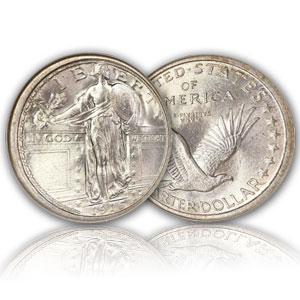
The Standing Liberty quarter was a 25-cent coin struck by the United States Mint from 1916 to 1930. It succeeded the Barber quarter, which had been minted since 1892. Featuring the goddess of Liberty on one side and an eagle in flight on the other, the coin was designed by sculptor Hermon Atkins MacNeil.
In 1915, Director of the Mint Robert W. Woolley set in motion efforts to replace the Barber dime, quarter, and half dollar, as he mistakenly believed that the law required new designs. MacNeil submitted a militaristic design that showed Liberty on guard against attacks. The Mint required modifications to the initial design, and MacNeil's revised version included dolphins to represent the oceans. In late 1916, Mint officials made major changes to the design without consulting MacNeil.
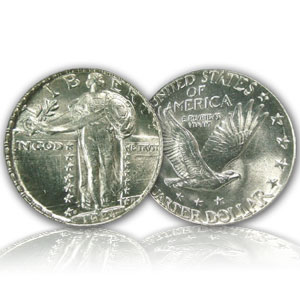
The sculptor complained about the changes after receiving the new issue in January 1917.
The Mint obtained special legislation to allow MacNeil to redesign the coin as he desired. One change made by the sculptor was the addition of a chain mail vest that covered Liberty's formerly bare breast.
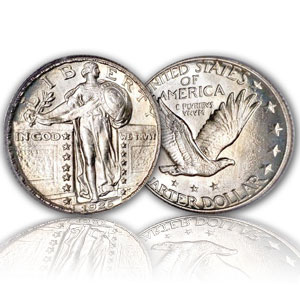
In circulation, the coin's date wore away quickly, and Mint engravers modified the design to address the issue in 1925. The Standing Liberty quarter was discontinued in 1931, a year in which no quarters were struck. By Congressional act the Washington quarter, featuring the first president's profile was introduced in 1932 to celebrate the bicentennial of his birth.
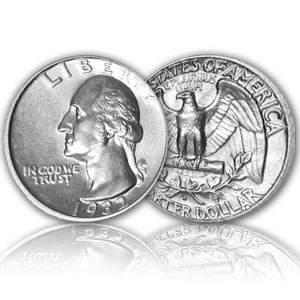
The Washington quarter is the present quarter dollar or 25-cent piece issued by the United States Mint. The coin was first struck in 1932; the original version was designed by sculptor John Flanagan.
As the United States prepared to celebrate the 1932 bicentennial of the birth of its first president, George Washington, members of the bicentennial committee established by Congress sought a Washington half dollar. They wanted to displace for that year only the regular issue Walking Liberty half dollar; instead Congress permanently replaced the Standing Liberty quarter, requiring that a depiction of Washington appear on the obverse of the new coin. The committee had engaged sculptor Laura Gardin Fraser to design a commemorative medal, and wanted her to adapt her design for the quarter. Although Fraser's work was supported by the Commission of Fine Arts and its chairman, Charles W. Moore, Treasury Secretary Andrew W. Mellon chose a design by Flanagan, and Mellon's successor, Ogden L. Mills, refused to disturb the decision.
The new silver quarters entered circulation on August 1, 1932; they were struck in that metal until the Mint transitioned to copper-nickel clad coinage in 1965. A special reverse commemorating the United States Bicentennial was used in 1975 and 1976, with all pieces bearing the double date 1776–1976; there are no 1975-dated quarters. Since 1999, the original eagle reverse has not been used; instead that side of the quarter has commemorated the 50 states, the nation's other jurisdictions, and National Park Service sites—the last as part of the America the Beautiful Quarters series, which will continue until 2021. The bust of Washington was made smaller beginning in 1999; in 2010 it was restored to bring out greater detail.